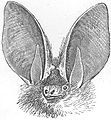Brown long-eared bat
| Brown Long-eared Bat | |
|---|---|

| |
| Scientific classification | |
| Kingdom: | |
| Phylum: | |
| Class: | |
| Order: | |
| Family: | |
| Genus: | |
| Species: | P. auritus
|
| Binomial name | |
| Plecotus auritus | |
The brown long-eared bat or common long-eared bat (Plecotus auritus) is a fairly large European bat. It has distinctive ears, long and with a distinctive fold. It is extremely similar to the much rarer grey long-eared bat which was only validated as a distinct species in the 1960s.
An adult brown long-eared bat has a body length of 4.5-4.8 cm, a tail of 4.1-4.6 cm, and a wing length of 4-4.2 cm. The ears are 3.3-3.9 cm in length, and readily distinguish this from most other bat species. This species appears to prefer caves as roosting sites, but sometimes roosts in trees as well. It is found across northern Eurasia, from England and France to Korea and Japan. It hunts above woodland, often by day, and mostly for moths. This is one of the bats for which eyesight is more important than echolocation in finding prey (Stevens 2005).
Echolocation
The frequencies used by this bat species for echolocation lie between 27-56 kHz, have most energy at 45 kHz and have an average duration of 2.5 ms. [1][2]
Gallery
-
Drawing by Ernst Haeckel
-
Detail of head
-
Woodcut from R. A. Sterndale, 1884
References
- Template:IUCN2006
- Stevens, Martin (2005): The role of eyespots as anti-predator mechanisms, principally demonstrated in the Lepidoptera. Biol. Rev. 80(4): 573–588. doi:10.1017/S1464793105006810 (HTML abstract)
- ^ Parsons, S. and Jones, G. (2000) 'Acoustic identification of twelve species of echolocating bat by discriminant function analysis and artificial neural networks.' J Exp Biol., 203: 2641-2656.
- ^ Obrist, M.K., Boesch, R. and Flückiger, P.F. (2004) 'Variability in echolocation call design of 26 Swiss bat species: Consequences, limits and options for automated field identification with a synergic pattern recognition approach.' Mammalia., 68 (4): 307-32.



